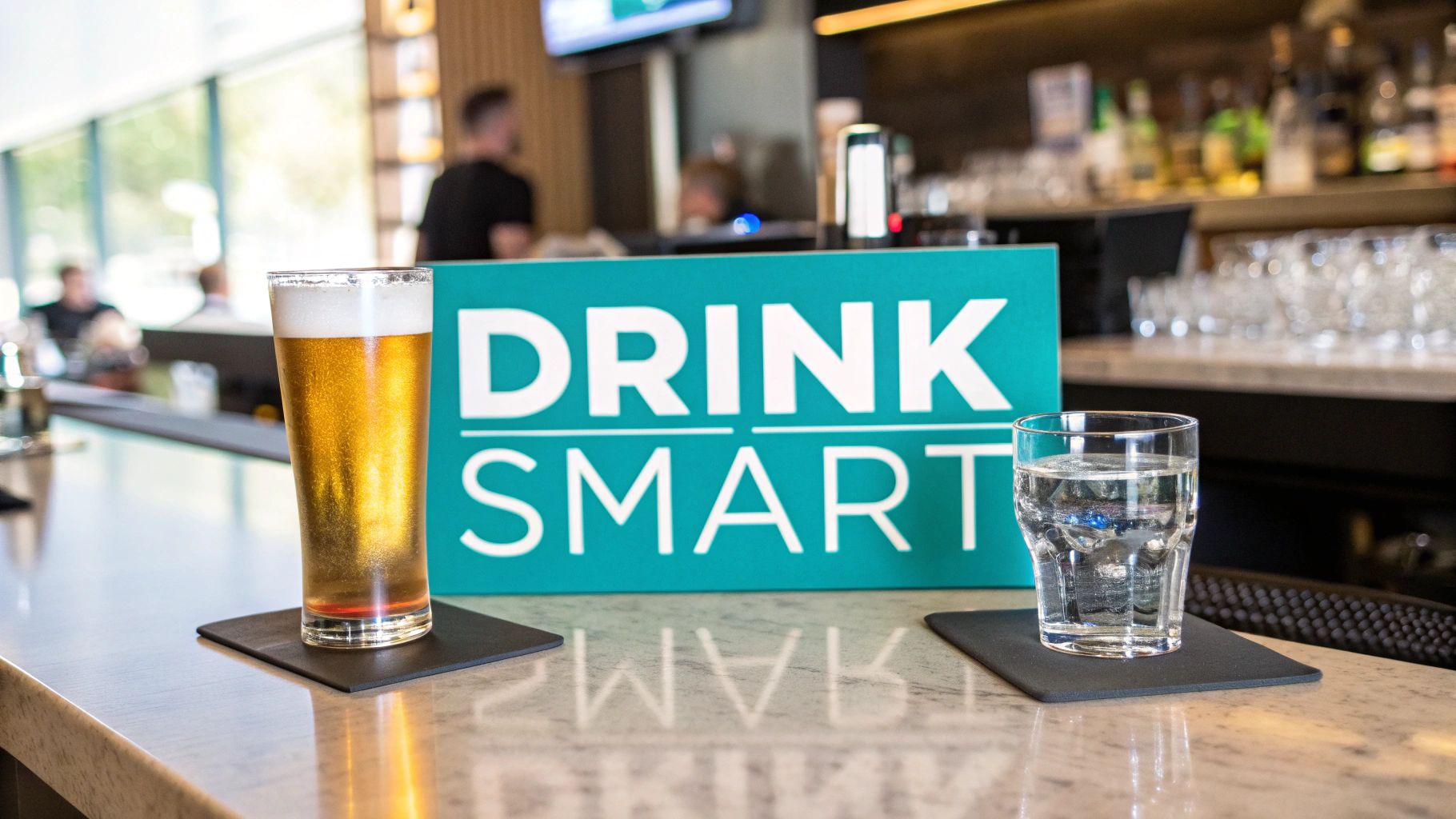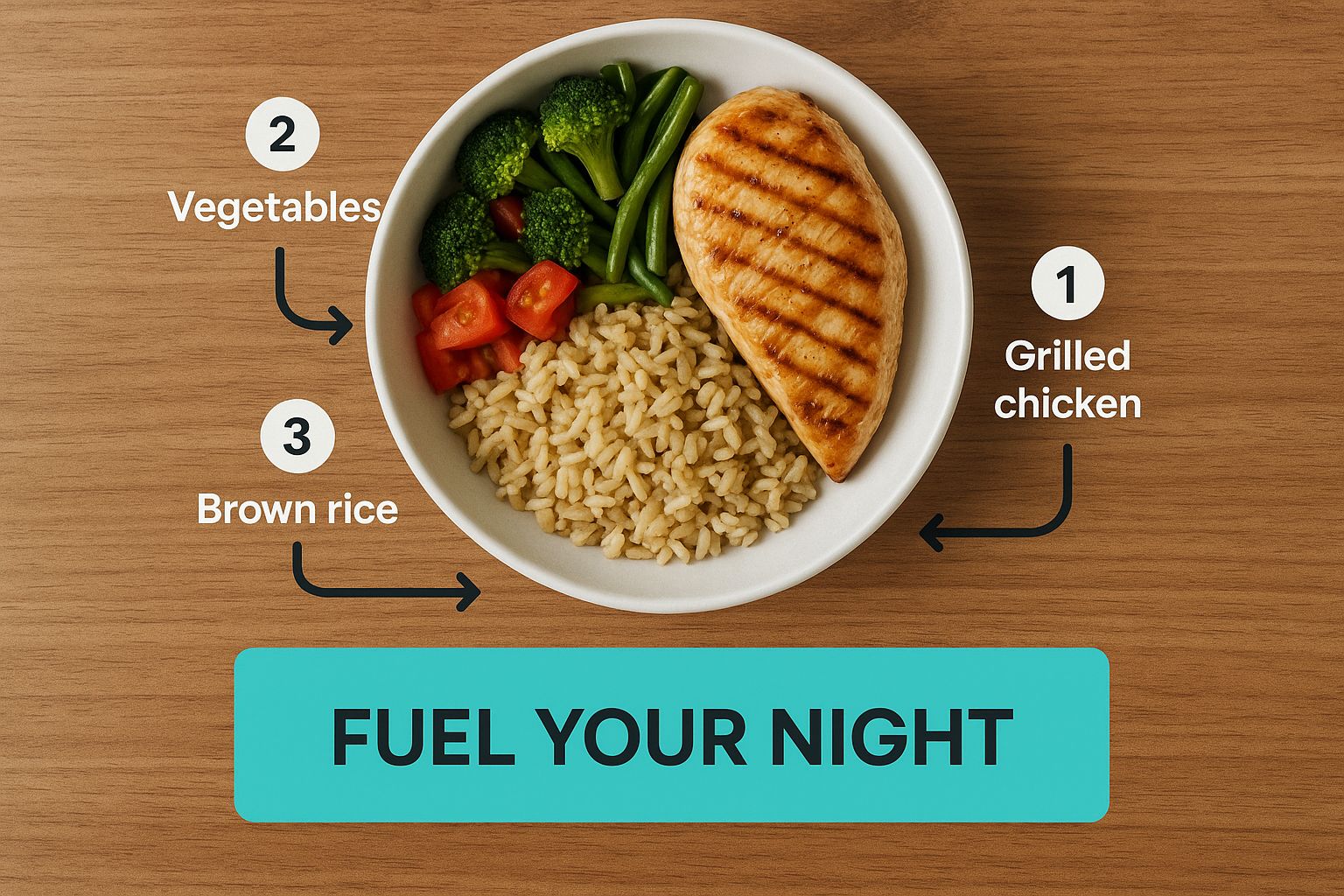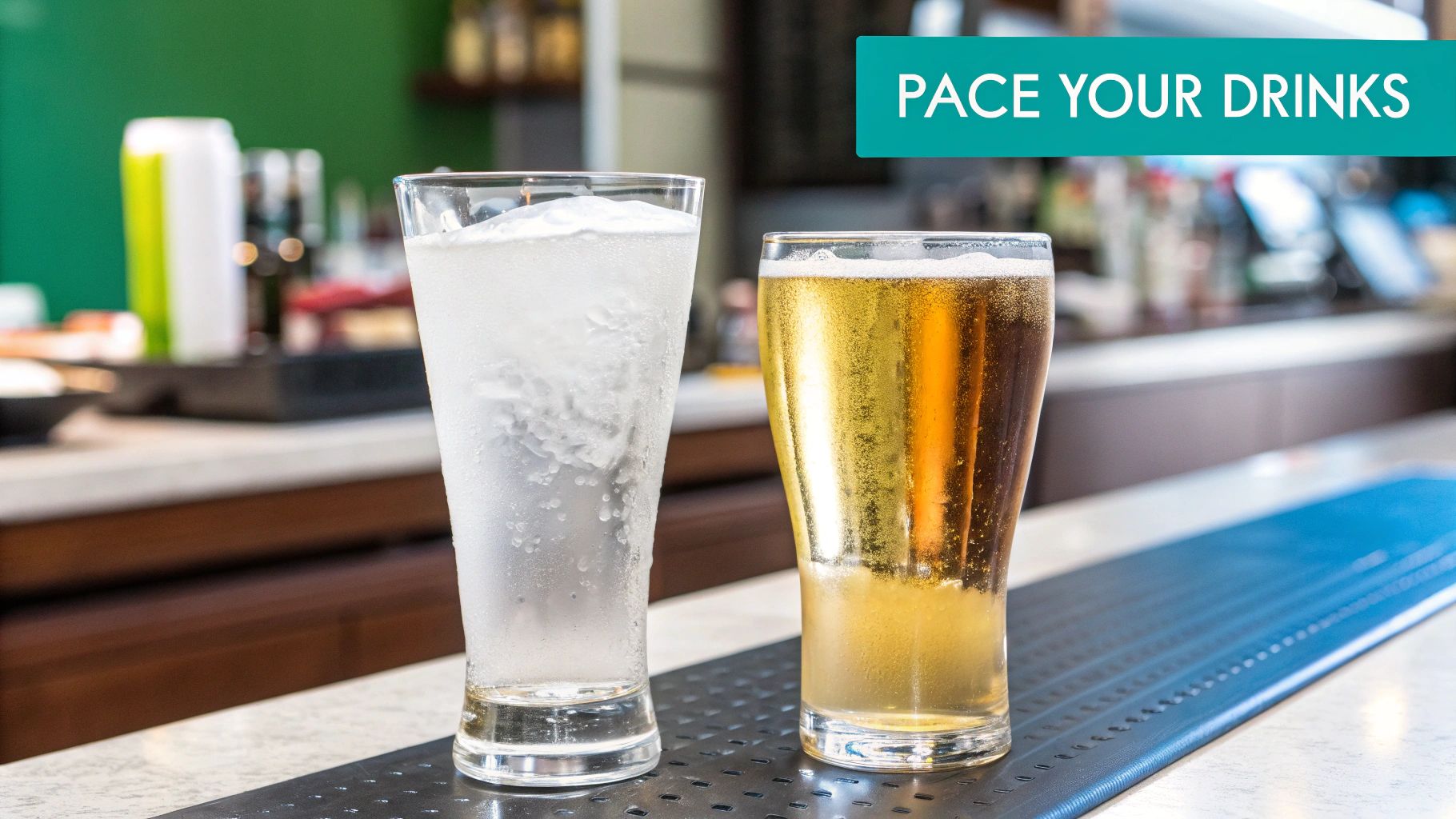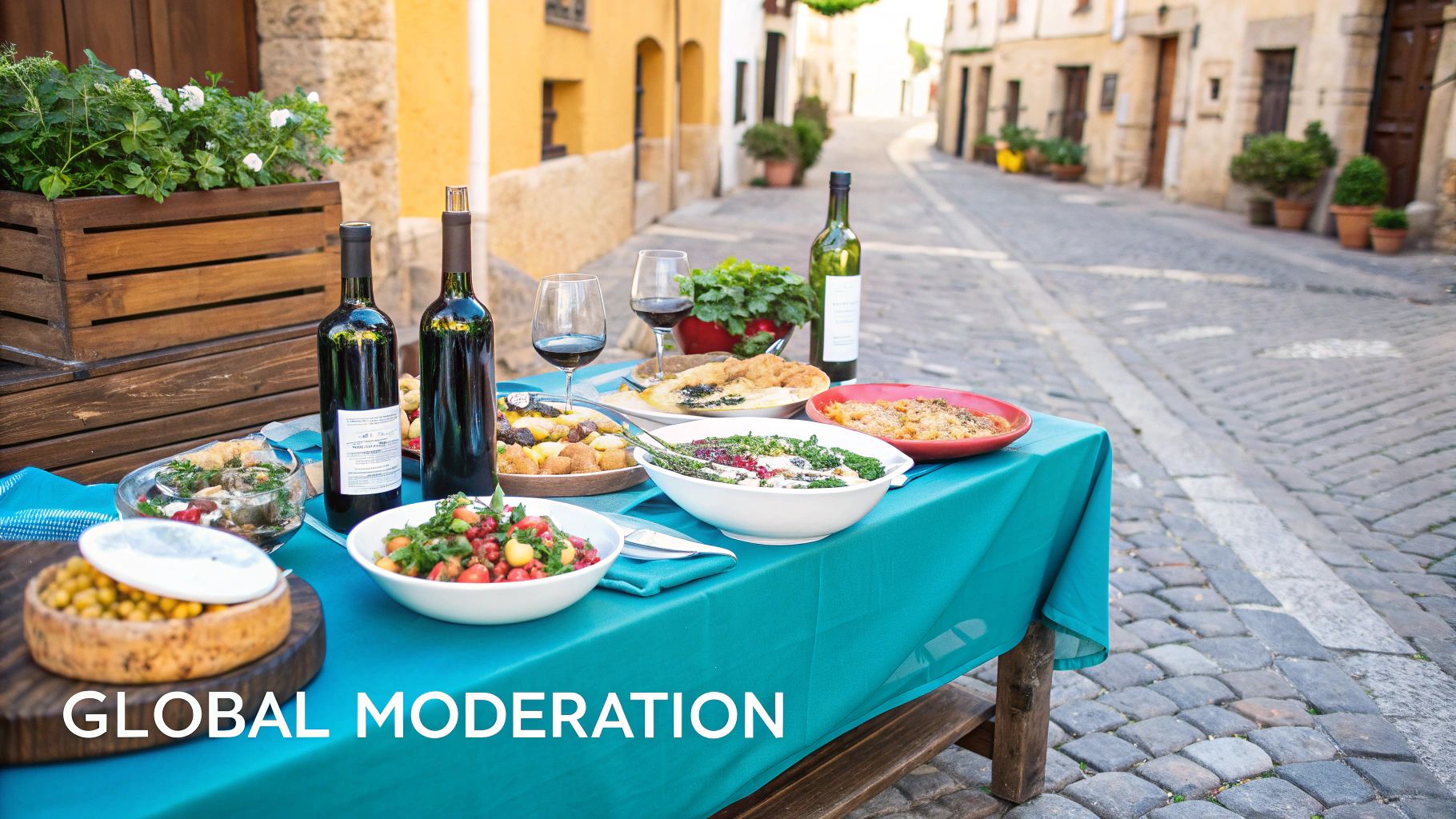

· By Annemarie
How to Drink Without Getting Drunk: Top Tips for a Safe Night
We've all been there—the night gets away from you, and suddenly you're feeling it a little more than you planned. But learning how to drink without getting drunk isn't about some secret trick; it's all about smart preparation. The real magic happens before you even take that first sip.
It all comes down to managing how your body absorbs alcohol and giving your metabolism the support it needs from the get-go.
Your Game Plan for a Balanced Night
A great night out often starts with a plan made hours before you even leave the house. Forget the old-school advice to just "line your stomach." A truly effective strategy is grounded in understanding how your body actually processes alcohol. Think of it as building a solid foundation so you can stay in control and, more importantly, feel great.
This isn't about holding back. It's about being proactive. When you prep your body for what's ahead, you can walk into any social event with confidence, knowing you've set yourself up for a good time from start to finish. For a deeper dive, check out our full guide on how to prepare for a night of drinking.
To make it even easier, here's a quick checklist to run through before you head out.
Pre-Drinking Strategic Checklist
This simple table breaks down the essential steps to take before your first drink. Following these will make a massive difference in how you feel throughout the night and the next morning.
| Action Item | Why It Works | Pro-Tip |
|---|---|---|
| Eat a Balanced Meal | Slows alcohol absorption by keeping it in your stomach longer. | Aim for a mix of protein (chicken, fish), healthy fats (avocado), and complex carbs (sweet potatoes). |
| Hydrate with Water | Alcohol is a diuretic; starting hydrated prevents dehydration from getting a head start. | Drink a big glass of water 1-2 hours before you go out. |
| Plan Your Pace | Decide on a rough "one drink per hour" pace ahead of time to avoid getting carried away. | Set a reminder on your phone for every hour to grab a water. |
Sticking to this simple routine creates a buffer, giving your body the tools it needs to process alcohol much more efficiently.
Fuel Your Body First
Seriously, this is the most important step. Make sure you eat a solid, balanced meal about one to two hours before you start drinking. A plate loaded with protein, healthy fats, and complex carbs is your best friend here. These nutrients slow down the rate at which your stomach empties, meaning alcohol trickles into your bloodstream instead of flooding it.
An empty stomach is like a VIP lane for alcohol, sending it straight to your system. A good meal, on the other hand, acts like a traffic controller, slowing everything down and giving your liver a fighting chance to keep up.
This infographic breaks down what that perfect pre-drinking meal looks like.

As you can see, a balanced plate is the foundation for slowing alcohol absorption and keeping your energy levels steady.
Know Your Body's Rhythm
One of the best strategies for a better night is simply matching your drinking pace to your body's natural limits. On average, the human body can process about one standard drink per hour. That's roughly a 12-ounce beer, a 5-ounce glass of wine, or a 1.5-ounce shot of liquor. When you drink faster than that, your blood alcohol concentration (BAC) starts to climb, and that's when you feel intoxicated.
The one-drink-per-hour rule is your golden ticket. By consciously spacing out your drinks, you give your liver the time it needs to do its job properly. It’s a simple change, but it's probably the most powerful tool you have for staying in control.
Mastering Your Pace in Any Social Setting

We've all been there. You head out for a fun night, telling yourself you'll "take it easy," but that vague plan quickly evaporates in a lively social setting. The real secret to enjoying yourself isn't avoiding alcohol; it's mastering your pace with a solid, actionable game plan.
This is all about mindful consumption. It’s less about restriction and more about being present—making conscious choices so you can stay in control and actually enjoy the experience, minus the morning-after regrets.
The One-for-One Rule
This is probably the single most effective trick in the book: the one-for-one rule. For every alcoholic drink you have, follow it up with a full glass of water. It's a simple habit that works wonders for two big reasons.
First, it keeps you hydrated. Alcohol is a diuretic, meaning it makes you lose fluids faster. Alternating with water directly combats this, which is a massive help both during the night and the next day. More importantly, it builds a natural buffer between your drinks, giving your body the time it needs to process everything.
Choosing Smarter Sips
Let’s be honest, not all drinks are created equal. Being a little selective can make a huge difference in how you feel. The first thing to check is the Alcohol By Volume (ABV), which tells you exactly how much pure alcohol is in your drink.
Here are a few ways to be more strategic with your choices:
- Go for Lower ABV Beers: That craft IPA might taste great, but it could be packing a 7-9% ABV. A light lager, which is usually around 4-5% ABV, is a much more sessionable choice.
- Try Spritzers and Highballs: A wine spritzer (just wine and soda water) or a highball (liquor with a generous pour of a non-alcoholic mixer) are fantastic options. They dilute the alcohol, letting you sip on something for longer without overdoing it.
- Watch Out for Sneaky Cocktails: Mixed drinks can be really deceptive. A Long Island Iced Tea, for instance, is loaded with multiple shots of different liquors and can have a sky-high alcohol content despite tasting sweet. Stick to simpler cocktails where you know what's going into the glass.
Quick reminder: a standard drink is defined as 1.5 oz of spirits, 5 oz of wine, or 12 oz of beer. Keeping this in mind helps you track your intake way more accurately, especially when you’re dealing with different glass sizes or potent mixed drinks.
Navigating Real-World Scenarios
Putting these rules into practice can feel a bit awkward at first, especially in certain situations.
What if you're at a pub and a friend keeps buying rounds? You don't have to keep up. A pro move is to order a non-alcoholic beer or a soda with lime for yourself when it's your turn. Honestly, most people won't even notice the difference.
Or maybe you’re at a fast-paced party. Simply holding a drink—any drink—can make you feel more in the mix. Keep a cup of water or soda in your hand. It stops people from constantly trying to top you up and puts you in the driver's seat. Learning these little social hacks is a key part of figuring out how to pace yourself when drinking without feeling like you're missing out. It all comes down to having a plan and sticking to it.
The Rise of Mindful Drinking
https://www.youtube.com/embed/jkzaQ_z3Pp4
Making the choice to drink without getting drunk isn't some fringe idea anymore—it's quickly becoming a major cultural shift. The days when heavy drinking was just the default social setting are starting to fade. A new mindset is taking over, one that's all about feeling good, staying present, and actually remembering the night.
This movement has a few names, like mindful drinking or being "sober curious." It's not about giving up alcohol completely. It's more about pausing to question your relationship with it. It’s about asking yourself, "Do I really want this drink, or am I just on autopilot?" That simple question puts you back in the driver's seat, making drinking an intentional choice instead of a mindless habit.
A New Generation of Drinkers
This isn't just a vibe shift; the numbers are telling the same story. Recent trends show a clear drop in alcohol consumption and a major uptick in more conscious drinking habits. This change is especially noticeable among younger generations, who are more dialed into their health than ever before.
A recent Gallup poll really put a number on it, finding that the U.S. drinking rate has hit a new low. A whopping 49% of Americans are now actively trying to cut back. Even more telling is the explosion of movements like Dry January, with 30% of adults giving it a shot—a huge jump from just the year before. This trend is being led by Gen Z, where 65% plan to drink less in general and 39% want to stick with a drier lifestyle long after January is over.
Joining the mindful drinking movement means you're part of a massive, growing community. It’s a shift from counting drinks to making drinks count—where the goal is to enhance an experience, not escape from it.
More Choices Than Ever Before
Honestly, one of the best parts of this whole cultural change is the incredible explosion of high-quality alternatives. The market has finally caught up to the demand for better non-alcoholic (NA) and low-alcohol drinks, and the results are pretty amazing.
Long gone are the days when your only non-drinking option was a sugary soda or a boring glass of water. Today, you can find a huge variety of sophisticated drinks that give you all the complexity and flavor of their boozy counterparts, but without the baggage.
Just look at what's out there now:
- Non-alcoholic spirits: Think distilled botanicals that create complex, flavorful bases for mocktails that seriously taste like the real thing.
- Craft NA beers: Breweries are now pumping out award-winning non-alcoholic IPAs, stouts, and lagers that are genuinely delicious. No more watered-down imposters.
- Low-ABV cocktails: A lot of bars now have creative, low-alcohol drinks on the menu that are perfect for sipping all night without losing your edge.
- Sparkling teas and shrubs: These bring unique, adult flavor profiles to the table that are both refreshing and interesting.
This growing market makes it so much easier to make a different choice without feeling like you're missing out on the fun. Diving into these options can open up a whole new world of flavors. For some great starting points, check out our guide on some of the best healthy alternatives to alcohol.
Proactive Support for Your Body
Even if you nail your pacing and eat a solid meal, your body is still putting in a ton of work to process every drop of alcohol. It’s a demanding job that drains vital nutrients and puts a major strain on your system—especially your liver. Thinking about how to drink without getting drunk is only half the battle; you also have to think about how to support your body's natural defenses.
This is where being proactive makes all the difference. Instead of just dealing with the aftermath the next morning, you can give your body the tools it needs to handle the night more efficiently right from the start. It’s not about some magic cure, but about smart, forward-thinking preparation.
Go Beyond Pacing with Proactive Prep
A truly solid strategy is more than just sipping your drink slowly. It’s about arming your body with the key nutrients that alcohol is notorious for depleting. This is exactly where something like Upside Hangover Sticks fits perfectly into your pre-game routine.
The whole idea is simple: you support your body before you even have that first drink. By doing that, you're helping your natural metabolic processes gear up for the work ahead. This isn’t a reactive fix; it’s a proactive play to make sure your system is primed and ready.
This screenshot from the Upside website really gets to the heart of their philosophy: proactive, science-backed support.
The main takeaway here is the focus on a "better morning" by using a product that’s convenient, clean, and built on proven ingredients. It lines up perfectly with a more mindful approach to drinking.
The Science of Smart Support
The ingredients in Upside are specifically picked to help your body’s natural functions, particularly the ones that break down alcohol's nasty byproducts. Let's get into a few of the key players:
- Dihydromyricetin (DHM): This is the star of the show. It's a powerful plant extract that’s been studied for its ability to support the liver enzymes that metabolize alcohol and its toxic byproduct, acetaldehyde. Basically, it helps your body's cleanup crew work more efficiently.
- Milk Thistle: You’ve probably heard of this one. Milk thistle has been used for centuries to support liver health. Its active compound, silymarin, is a potent antioxidant that helps protect your liver cells from stress.
- B Vitamins: Alcohol can burn through your body’s supply of B vitamins, which are absolutely essential for energy. Topping them off beforehand helps fight that drained, next-day sluggishness.
- Electrolytes: Because alcohol is a diuretic, you lose crucial minerals like sodium and potassium. Replenishing these helps you stay hydrated and keeps your muscles and nerves firing correctly.
Think of it like this: prepping your body with these ingredients is like stretching before a workout. You’re getting your system ready for the strain, which means better performance and a much smoother recovery. Grabbing an Upside stick before you start drinking is the easiest way to lock this crucial step into your plan.
Global Lessons in Moderate Drinking

How we drink is often just a reflection of where we live. While your local bar scene might have its own vibe, looking at how other cultures handle alcohol can teach us a ton about enjoying a drink without overdoing it.
It’s about seeing alcohol as a complement to life, not the main event. By exploring these different approaches, you can pick up some time-tested strategies for more mindful drinking. It's a good reminder that moderation isn't some new wellness trend; it's a skill people have valued forever.
The Mediterranean Model: Food First
Ever notice how in Italy or Spain, wine is just part of the meal? It’s rarely the star of the show. Instead, it’s woven right into the dining experience, something to be sipped and savored alongside good food and conversation.
This simple habit naturally pumps the brakes on consumption. When you're enjoying a glass of wine over a two-hour dinner, your body has plenty of time to process the alcohol. The food itself acts as a buffer, preventing those quick spikes in blood alcohol that get you drunk fast.
The big lesson here is surprisingly simple: Treat alcohol as an accompaniment to food, not an appetizer. This mindset shift moves the focus from drinking quickly to enjoying the entire moment, making it much harder to over-consume.
European Social Drinking Norms
Think about a German beer garden or a British pub. These places are social hubs, first and foremost. While plenty of beer is consumed, it’s often lower-ABV brews enjoyed over hours of conversation. The main goal is the get-together, the shared time, the stories—the drinks are just there to help things along.
This is a world away from a culture of pre-gaming and taking shots. When you adopt a more social mindset, you're less likely to rush through your drinks because you're more invested in the actual connection with the people you're with.
Global Consumption Patterns
Of course, drinking habits are also deeply shaped by cultural and religious norms. The World Health Organization has shown just how different alcohol consumption is around the world. While some European countries top the charts, many predominantly Muslim nations have minimal intake because of religious prohibitions. It just goes to show how powerful social expectations can be.
You can dive deeper into the data on global alcohol consumption patterns and rankings to see the full picture.
By looking at these different playbooks, you can start building a more balanced and intentional relationship with alcohol—one that actually works for you.
Common Questions About Drinking Smarter
Even when you go into a night with the best intentions, questions always come up. Knowing how to handle these common situations is the key to mastering the art of drinking without getting drunk. Let's walk through some of the things people ask all the time so you can feel more in control.
Does the Type of Alcohol Really Matter?
This is a classic one. A lot of people think the kind of drink—whether it's wine, beer, or liquor—is what gets you drunk. But the truth is, it's really about two things: the Alcohol By Volume (ABV) and how fast you're drinking.
A "standard drink" has roughly the same amount of pure alcohol. That means a 1.5-ounce shot of vodka, a 5-ounce glass of wine, and a 12-ounce can of beer are all in the same ballpark.
The real trouble starts with how you drink them. Shots, by design, go down fast and cause a big, quick spike in your blood alcohol concentration (BAC). Cocktails can be just as sneaky. All that sugar and fruit juice can easily hide how much alcohol you're actually consuming, making it way too easy to have more than you planned. If you want to stay in control, stick with lower-ABV options and make a point to sip, not chug.
Can I Sober Up Quickly if I Feel Too Drunk?
We've all been there, wishing for a magic "sober up now" button. Sadly, it just doesn't exist. Once the alcohol is in your system, only time will bring your BAC back down. Your liver is the hero here, and it works at its own pace—metabolizing about one standard drink per hour. You can't speed it up.
Things like a cold shower or a strong cup of coffee might wake you up a bit, making you feel more alert, but they do absolutely nothing to lower the amount of alcohol in your blood. You're still just as impaired.
There's only one real way to handle it: stop drinking alcohol. Immediately. Switch over to water to start rehydrating and just give your body the time it needs to do its job.
How Do Body Weight and Gender Affect Tolerance?
Your body makeup plays a massive role in how you process alcohol. It all comes down to how alcohol dissolves in your body's water.
- Body Size: Simply put, a larger person usually has more body water to dilute the alcohol. This means they'll often have a lower BAC than a smaller person who drinks the exact same amount.
- Gender: Biology matters here. Women typically have a higher percentage of body fat and less body water than men of the same weight. On top of that, they tend to have lower levels of alcohol dehydrogenase, a key enzyme in the stomach that starts breaking down alcohol before it even hits the bloodstream.
This combination means alcohol can hit women harder and faster, leading to a higher BAC more quickly. Understanding these built-in differences is crucial for figuring out what your own personal, safe limits look like.
The best way to guarantee a good night out (and a better morning after) is to be proactive. Upside Hangover Sticks are designed to support your body's natural processes. Just make them part of your pre-party routine and see the difference for yourself. Learn more at https://enjoyupside.com.
#upside #enjoyupside #upsidejelly #livemore #hangovercure #hangoverprevention #fighthangovers #preventhangovers #HangoverRelief #MorningAfter #PartySmarter #HydrationStation #WellnessVibes #RecoverFaster #NoMoreHangovers #HealthyParty #HangoverHacks #FeelGoodMorning #NightlifeEssentials #HangoverFree #SupplementGoals #PostPartyPrep #GoodVibesOnly #HealthAndParty #HangoverHelper #UpsideToPartying
